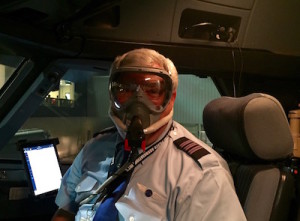Podcast: Play in new window | Download
Subscribe: RSS
Pre-Flight Checklist:
 Carl, Tom, Paul, the other Tom, Russ, and Eric are all on this episode to discuss how to be prepared for an in-flight fire.
Carl, Tom, Paul, the other Tom, Russ, and Eric are all on this episode to discuss how to be prepared for an in-flight fire.
Eric announced that Polk State University recently had their first hiring visit from Express Jet, which gave conditional offers to seven of his students. Eric also announced that he actually got to get in an airplane today for some observation in a 172.
Carl announced that the 2016 edition of the Aerospace Scholarships guide will be out shortly on Amazon.
Paul has been mentoring a friend named Doug that recently completed his private rating in 12 days, and then went ahead and finished his commercial rating.
Tom Frick announced that he recently taught a student named Mark through his private rating so he could fly drones.
Cruise Flight:
- Carl recently had a flight where smoke was detected in the bathroom of the plane he was flying. He discussed the procedure of the pilot and flight attendants investigating where the smoke is coming from.
- Eric said smoke and fire is discussed in training, but might not be trained enough for it in a form of practice.
- Eric said you don’t have time to pull out a checklist and flip through it, you must have “immediate action items” that you memorize and do immediately.
- Paul discussed a fire he had on a flight and how he got back to an airport safely. He said his instructors trained him very well to be prepared for a fire emergency.
- Paul also discussed another fire he heard about where a crew did not land a plane with a fire because they were going through checklists, not wanting to land overweight, etc. rather than just landing the plane, which ultimately crashed.
- Tom W. and Carl discussed procedures and equipment for dealing with laptop and phone batteries which sometimes catch fire on a plane and are almost impossible to put out.
- Tom also mentioned that it’s a good idea to practice these procedures in the simulator because when the cockpit fills with smoke, you can’t see the controls and sometimes you need to just know where the controls are.
- Three components to a fire: oxygen, heat, and fuel. If you take any one of those away from the fire it will go out.
After Flight Checklist:
~Picks of the Week~
Russ: FAA Instrument Flight Procedures Gateway-which lists charts and upcoming changes at all airports. You can also create an account to get updates to airports you use.
Tom F: Garmin Pilot– A comprehensive suite of Android navigation apps designed for GA and corporate pilots
Paul: Everything Explained for the Professional Pilot– A book that explains flight rules and regulations without confusing jargon.
Carl: Fore-Flight– Electronic flight bag and apps for pilots
Tom W: Wind Map– a website that shows wind patterns to help you plan your flight
Carl: Sunset Pub and Grill at Lincoln Park airport– A great restaurant to eat at and watch planes take off and landLincoln Lincoln

Hi guys,
Just listened to the episode on inflight fires. Great job and very insightful. I wanted to add some of my own thoughts to the discussion.
I applaud the general aviation communities efforts to take from the airlines best practices that can enhance safety. I sometimes do wonder however just how valid our airline training is? My airline which has similar training to most other large airlines gives you 2 sim events yearly. One is a 1 day Proficiency Check PC ride that is a 4 hour session. Two is a Proficiency Training PT ride that is a two day event with 4 hour sessions. The PC is a “jeopardy” event that includes all the basic maneuvers required by the FAA. Keep in mind that there are two pilots in the sim and each does the same maneuvers so in reality each session is only 2 hours of stick time. During the PT which in theory allows some latitude for the instructors to “re train” failed maneuvers the ride can still be failed if the pilot works hard enough at it. The first day of the PT is basically the same maneuvers as the PC leaving the second day for things like stalls, steep turns and a variety of system demonstrations. The simple fact of the matter is that there is so much to get through with all the compulsory maneuvers there is very little time left over for anything else. We are literally shooting approach after approach with no time between for debriefing or thoughts about lessons learned. All of the maneuvers are highly scripted. The pilots know beforehand what is going to happen. Training policies prohibit the insertion of multiple system failures or “out of the box” teaching moment techniques by the instructors. Don’t get me wrong I’ll still put the North American airline pilot up against just about any other pilots around the world but IMO and that of a growing number of other aviation professionals our approach to flight training could use some tweaking to maximize it’s effects. There are many types of system failures possible you will not likely ever see in the airline training program. The time is not available to fully see the failure and follow it through it’s entire evolution to a successful landing. Economics plays a large role in this. Level C full flight simulators FFS are expensive and airlines are loathe to spend money on anything not strictly required. The assumption is professional pilots shouldn’t need anything more. I have slightly different thoughts on the matter.
A few years ago we did have the opportunity to do some advanced simulator sessions that focused on things like ditching, in-flight fires and unreliable flight instruments. Seeing the failures for the first time had a real impact on a lot of crews. It allowed pilots to see just how complex a situation can become and the amount of time necessary to fully work through procedures like those required for smoke or fire. As you say ultimately the pilot flying should be working as rapidly as possible to get the aircraft on the ground. The pilot monitoring needs to try and get through the procedures as best he can but what remains unfinished in the flare will just have to come along for the ride. It should be stressed that just as crews have allowed their craft to burn while slavishly following the book so to have crews made situations worse by acting brashly. Finding the proper balance between expedience and procedure is a real key component of airmanship that can only be developed through training and experience.
You also touched on the idea that situation based training is a powerful tool. We don’t necessarily need a simulator or an airplane to brainstorm various scenarios. We can “sofa” fly many procedures. Get creative and make up your own scenario. Challenge your fellow pilots and friends with it. Don’t forget pilots have emergency authority during crises and no FAR is inviolate to the extent you believe your actions are necessary for the safe completion of the flight. Max gear down speed is 280knots? Would the airplane come down faster at 300 or 320? Would the gear doors stay on? Do we care? Are we asking or telling ATC what we need? You’re the boss once the emergency is declared and all players are working for you.
How many people have ever tried wearing a full face oxygen mask while attempting to communicate with a crew member or while hand flying a flight control compromised aircraft or one with smoke in the cockpit restricting visibility? All the procedures require its use but many airlines don’t enforce it because it’s inconvenient in the sim. Think about what it would be like in this situation with a gaping hole and associated noise. How would YOU communicate? For a lot of this there may be more than one good answer or solution. Having thought about things before hand is key as it is unlikely your ability to come up with clever solutions will suddenly appear at the moment your central nervous system is bombarded with the sudden realization that your mortal time may be nearing it’s end.
I can relate to being drop kicked into a state of higher consciousness by a lavatory smoke alarm at 3 a.m. in the middle of a long cross country. Didn’t have any trouble staying awake the rest of the morning LOL. People who fly with smoke detector equip aircraft should be aware that aerosol sprays can set them off. In our case a woman was going to town on her doo with a can of hairspray in the lavatory.
I fly model aircraft for recreation and have quite a bit of experience with Lithium polymer or LIPO batteries. This technology makes our world go round these days but it can also bring to a stop if we don’t treat it wisely. The FAA is currently advising airlines to be careful about consumer devices that contain batteries well outside the limits of what is allow. Hover boards are one example. The FAA is also looking at further restricting battery carriage. Lithium batteries are generally quite stable and safe but there are a few times we need to be especially cautious with them. The chemistry inside is very intolerant of being over or under discharge. This can quickly ruin their capacity. If over charged the chemicals get hot and release gasses internally. The batteries can swell up and if not caught early will eventually get so hot that they will experience thermal runaway and “vent”. This is basically the chemicals coming into contact with air at which point they spontaneously ignite. This brings up another LIPO safety tip. These are assembled with prismatic cells that are soft sided. If you carry these batteries take reasonable precautions to ensure that they can not be cut open by something sharp inside your bags. Batteries should never be out of reach of an aircraft’s occupants ie in the cargo hold. Having access to batteries means they can be monitored and steps taken early on if they begin to show signs of distress like getting hot or swelling up. The hobby industry has developed lipo bags that are basically fireproof bags that can withstand a lipo battery destroying itself. https://www.commonsenserc.com/product_info.php?products_id=186 This one is only $15 U.S. The bag will contain the flames but it will vent the fumes and trust me having crashed enough of my little flying machines a burning LIPO is not something you want to smell up close. Also you need to get the battery in the bag before thermal runaway happens. Trying to pick up a burning lithium battery is guaranteed to cause very bad burns. Honestly if it were me in an aircraft that I could open in flight I think I find an open field to deposit a threatening battery on before I’d want it going off on board even in a lipo safe bag.
The best way to deal with fire in flight is not to ever have one in the first place. In this vein I’ve never once lost a moments sleep having delivered people into the waiting arms of FAA security because their addiction to burning and inhaling weeds had become so great they’re willing to sacrifice everyone else’s safety to feed it.